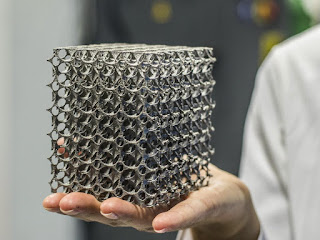Link to oxygen sensors
Plasma atomization is used in many applications, including 3D printing. First developed in 1998, this technique has risen to become the industry standard process for creating reactive metal powders suitable for 3D printing. Learn how plasma atomization works and why you need an oxygen monitor to stay safe with plasma atomization.
How Plasma Atomization Works
Plasma atomization is used
not only in 3D printing, but in any circumstance where powder metallurgy is
needed. Other uses include spray coating, cold spray, and metal injection
molding. To pulverize metal, wire is fed through a tube, then hit by three plasma torches capable of reaching temperatures of 10,000 degrees Celsius. As the wire liquefies and melts, individual droplets shear off and fall into a chamber filled with argon gas and cooled by water. When the drops of metal hit the argon, they solidify into spherical droplets. This process produces a fine, uniform metal powder. After the wire has been transformed into droplets, the powder is sieved to ensure uniformity. This is key to the success of the 3D printing process, which relies upon fine grade, uniform powder.
Titanium (Ti), Nitinol, Niobium, Aluminum, and other reactive metals and their alloys can all successfully be atomized through this process. Variables in the plasma atomization process allow workers to create droplets of different sizes, for different end uses.
PureAire offers an oxygen analyzer, which many 3D printing manufacturers utilize. This device helps monitor the levels of oxygen in ppm, from 0 to 1000, while the atomization process takes place.
It's important to keep oxygen levels low while the Ti and other base metals are being turned into powder, as this ensures the purity of the final product. Oxygen analyzers provide a continuous readout of oxygen levels inside the chamber, so your workers can ensure the highest levels of purity at a glance.
Argon gas is used during plasma atomization because it helps ensure the purity of the powdered metal by reducing the chance for chemical reactions that might happen if oxygen interacted with the metal during the atomization. As long as the argon gas remains in the chamber where the aluminum or titanium powder is being made, plasma atomization is quite safe. Like other inert gases, argon depletes oxygen from the atmosphere. Were the argon gas to leak out of the plasma atomization chamber, employees' wellbeing could be at risk.
Why You Need an Oxygen Monitor with Plasma Atomization
When argon escapes into the
environment, it displaces oxygen molecules. Since the gas is both odorless and
colorless, there is no way to detect an argon leak by sight or smell. If there
are several atomization stations creating Ti or titanium powder at once, the
risk increases exponentially. Once oxygen levels begin to drop, worker safety becomes a concern. If oxygen levels fall below the minimum set by OSHA, workers can suffer respiratory and cognitive impairment. Symptoms include dizziness, confusion, fatigue, and shortness of breath. Even a brief exposure to an oxygen deficient environment can prove deadly.
Fortunately, an oxygen deficiency monitor can continually weigh oxygen present in the room, alerting staff before oxygen levels plunge below the OSHA threshold. This provides sufficient notification via flashing lights and loud alarms for staff to exit the room to safety.
PureAire offers an oxygen monitor with a zirconium sensor. Unlike other sensors, this lasts with no maintenance and no calibration once the O2 monitor is installed. The O2 monitor and oxygen analyzer, when used together, allow for precise manufacturing of powdered metals with low risk to workers. Businesses prefer PureAire products, which are low-maintenance, cost-effective, and reliable for 10+ years. Visit www.pureairemonitoring.com to learn more about our oxygen analyzers and monitors.



